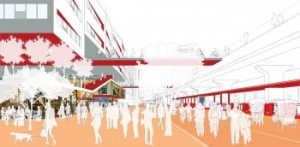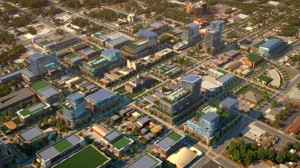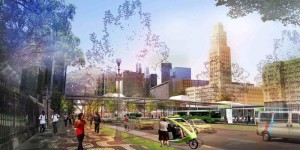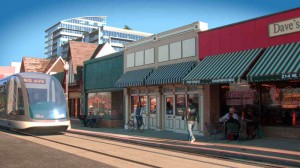Why Everyone Should Be a Futurist
By Bill Becker
May 2012
In hearing rooms, hallways, and conferences where the world’s policymakers are wrestling with the big issues of our day, something important is missing.
Vision.
By vision, I don’t mean those forward-looking policy papers that tell us how we might shape the future with a global Green New Deal, or the Millennium Development Goals, or a Copenhagen Accord. Those intellectual constructs are critical, but they are not enough.
We’re missing visions of the right-brain variety—immersive, lifelike, visual images of the future we want, conveyed with the same powerful technologies that moviemakers use to entertain us and the advertising industry uses to sell us things. Think about it. Wouldn’t it be interesting if we mobilized our visual arts and tools to change sustainable development from an abstraction into something we all can see?
In the brutal battles over public policy these days, visions of the kind I’m describing seem fluffy, as though we’re entering the arena with swords made of cotton instead of steel. However, as the late Donella Meadows put it, “Vision is the most vital step in the policy process. If we don’t know where we want to go, it makes little difference that we make great progress.”1
This is not to say our communications industries don’t show us anything about the future. But they focus on the future we must avoid rather than the future we must create. It’s likely that the apocalypse is coming right now to a theater near you. Think of The Day After Tomorrow, The Road, An Inconvenient Truth, The 11th Hour, or 2012, to name a few movies in recent years. We’ve seen endless television shows on the frightening prophecies of Nostradamus and the Mayan calendar. The Discovery Channel has shown us in nightmarish detail Ten Ways the World Will End. Apparently thinking it’s a public service to help us prepare, the channel is airing a series called Doomsday Shelters in which families who call themselves “preppers” are building underground shelters stocked with food, weapons, and ammunition. News media are governed by the “if it bleeds, it leads” rule, showing us economic collapse, homelessness, war, terrorism, natural disasters, and other symptoms of social collapse every evening at dinnertime. We revel in our fears but do not reveal our dreams.
For what would seem to be sound tactical reasons, environmental advocates also focus on fear as a motivator. The “fight or flight” reaction seems to be a more powerful force for change than happy visions of security and abundance. The prominent British environmentalist Jonathon Porritt notes that there is a continuing lack of any compelling narrative focusing on the upside of living within environmental limits rather than on the multiple downsides of exceeding those limits. Many more people count themselves as environmentalists out of a desire to avoid a potential ecological apocalypse rather than out of a belief in some “Promised Land” flowing with organic milk and rainforest honey.
What would a solar city look like? Perhaps something like this computer-generated image of Kansas City, Missouri, with solar electric panels and green roofs on top of nearly every building.
He continues:
This lack of a compelling upside narrative exposes environmentalists to the rabble-rousing charge of being anti-progress and anti-aspiration—a charge that sounds more and more convincing as more and more environmentalists let it be known that they believe it is either “already too late” to do anything about the gathering apocalypse, or, in order to avoid it being too late, that we need to go onto an instantaneous “war footing” to combat accelerating climate change—whatever the consequences for democracy. For wholly understandable historical and intellectual reasons, today’s environmental discourse is still shaped far more powerfully by the language of “scarcity” and “limits” than it is by any compelling upside narrative. But fear of the future does not empower people; it debilitates and disempowers.2
We can find a corollary in international negotiations, where the conversation is about which nations will sacrifice growth to cut carbon emissions, rather than who will be the first to seize the enormous opportunities in a global transition to sustainability.
The resulting stalemate makes us pessimistic that our international institutions can deal with this century’s global problems. That pessimism can easily become a self-fulfilling prophecy. Paul Ray and Sherry Ruth Anderson, authors of The Cultural Creatives: How 50 Million People Are Changing the World, write, “Today as we are besieged by planetary problems, the risk is that we will deal with them in a pessimistic and unproductive style. Transfixed by an image of our own future decline, we could actually bring it about.”3
In the best case, problems push us to action. But to find its sense of direction, the “push” needs help from the “pull” of positive vision. The Transition Town movement, a grassroots network that began in the United Kingdom, helps communities become more resilient against threats such as peak oil, climate change, and economic instability. That’s a response to “push.” But the movement’s founder, permaculture expert Rob Hopkins, also understands the power of “pull”:
It is one thing to campaign against climate change and quite another to paint a compelling and engaging vision of a post-carbon world in such a way as to enthuse others to embark on a journey toward it. We are only just beginning to scratch the surface of the power of a positive vision of an abundant future.4
Business has long understood the power of vision in attracting customers. General Motors illustrated it more than 70 years ago at the New York World’s Fair. In the hangover of the Great Depression, GM commissioned theatrical designer Norman Bel Geddes to create Futurama, a pavilion in which an estimated 20 million visitors were conveyed through models of life 20 years in the future. At its core, GM’s vision was a dynamic, highly mobile, car-centered society—an appealing alternative to the life many of the visitors were experiencing. A case can be made that GM’s vision built public support for the way we’ve designed cities and transportation systems ever since.
But the 1930s GM model doesn’t work anymore. We need a new vision.
The Future We Want
In 2009, Michael Northrop, the director of the Rockefeller Brothers Fund’s sustainable development program, convened 30 sustainability and communications experts to explore why the public was not more engaged in fighting for a more sustainable world. We who participated talked about “apocalypse fatigue”—the tendency for people to withdraw from solving problems that seem overwhelming and unsolvable. We also observed that today’s social media and the Internet make it possible to have a global conversation about “push” and “pull.” We decided that we need to help the broad and largely disengaged public understand the future we can build, based on visions that are realistic, achievable, and positive.
That was the inception of a project now called The Future We Want. We are inviting people around the world to share their ideas about what they want their communities and lives to be like 20 years from now. We are mobilizing world-class technologists, designers, planners, and artists to show us what life would be like if we confronted today’s challenges head-on and built a world that reflected people’s hopes.
In 2011, we took the project to the United Nations, which was planning Rio+20—its Conference on Sustainable Development in June 2012 on the 20th anniversary of the first Earth Summit. With agility uncharacteristic for such a large institution, the United Nations’ entire chain of command adopted “The Future We Want” as the official tagline for Rio+20. Secretary-General Ban Ki-moon announced it on November 22, 2011; a few months later, he embraced it as the theme for his next five-year agenda at the United Nations.
As the project progressed, we found we weren’t the only organization engaged in exploring vision. My Green Dream, led by May East from the Findhorn community in Scotland, has deployed “dream catchers” around the world to collect short videos of people describing their aspirations for the future. Sustainia, a project of the Danish think tank Monday Morning, has organized a competition to identify the 100 best ideas to achieve sustainable societies by 2020. Rather than awarding its annual cash prize to an individual in 2012, TED launched City 2.0, calling for concepts on the city of the future. The Institute for Transportation and Development Policy in New York commissioned architects in ten cities around the world to draw what sustainable development would look like at specific blighted locations in each place.
Corporations, who see the future in terms of markets, are entering the dialogue too. Siemens has its own exhibit of the cities of tomorrow, as does its competitor, General Electric. Corning has produced a video on a futuristic “day made of glass.”
Some of the leaders in the world’s principal oil patch also are thinking about the future—in their case, the post-petroleum world. Years ago, a Saudi Arabian oil minister warned that oil reserves would not be depleted before renewable energy takes over the world’s energy markets. (In a quote for the ages, the minister, Sheikh Zaki Yamani, observed that the Stone Age didn’t end because we ran out of stones.) Today, the royal family in Abu Dhabi is positioning the United Arab Emirates as a global thought leader on sustainable energy, sponsoring an annual World Energy Futures Conference and working on the world’s first carbon-neutral city.
When thought leaders in Kansas City, Missouri, wanted to know what the impact would be if they invested in light rail, they hired the artists and urban design experts at Arnold Imaging to show them. The company produced a video that included this image of a light rail system on one of the city’s main streets. In the video, the company mixed footage of real people with the computer-generated image of the rail system to “populate” the future—in other words, to show how light rail would change the city’s streets and quality of life.
The contributions of these change agents and visionaries haven’t yet penetrated the world’s policy circles. We remain in a rut of oil and coal, flirting with even worse forms of fossil energy and with technologies we don’t know how to control, like nuclear energy, geoengineering, and carbon sequestration. The entrenched and well-financed fossil energy industries are so far more interested in finding ways to extend the oil age than they are in helping us achieve a new energy economy—an economy that would sustain them, too, if they made the transition with the rest of us. Lacking a better vision, the developing world still considers the Western model of consumption and car-dependent cities the highest expressions of progress.
But in this time in which our old institutions and systems are failing us; in which powerful and entrenched vested interests are fighting to maintain a status quo that cannot be maintained; in which the impacts of climate change are becoming more frequent, severe, and undeniable; and in which our confidence in the old economic order has been shaken, we have reached a teachable moment not unlike the one that General Motors seized in 1939.
It is time to envision the future we want, to get the global community talking about it, and to insist on the public policies that will allow us to achieve it. Given the finality of problems such as species loss, peak oil, and climate change, every day we delay makes the “upside narrative” less credible. But if we decide to grasp it, a future we want is still within reach. Buckminster Fuller had it right: “We are called to be architects of the future, not its victims.”
References
- Meadows, D in Getting Down to Earth, Practical Applications of Ecological Economics (Costanza, R, Segura, O & Martinez-Alier, J, eds) Envisioning a sustainable world (Island Press, Washington, DC, 1996).
- Porritt, J. Scarcity and Sustainability in Utopia. Insights Paper 4(4) (Durham University and the Institute of Advanced Study, 2011).
- Ray, P & Anderson, SR. The Cultural Creatives: How 50 Million People Are Changing the World (Three Rivers Press, New York, 2000).
- Hopkins, R. The Transition Handbook: From oil dependency to local resilience (Green Books, 2008).
vvlx,
hentai,
xporn,
xnxx,
sex việt,
Family Practice Doctors Near Me,
Ratify Treaties,
Best Hookup Apps,
Brunch On A Wednesday,
Comfortzone,
Plaza Premium Lounge Orlando Reviews,
Catering 77002,
Cauliflower And Coconut Curry,
Usa Rail Pass,
Active Duty Service Member,
Patch American Flag,
Farfetch Coupon Code,
Connect Google Mini,
Nike Mens High Top,
Bronny James Usc Basketball,
Anal Sex Prep,
Aesports,
Check Balance On Debit Card,
Add People Trustpilot,
Skype Ids,









